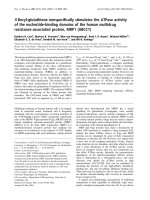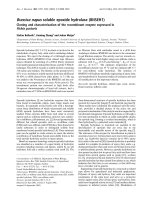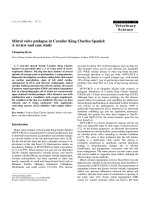Báo cáo y học: " Mitral valve replacement via right thoracotomy approach for prevention of mediastinitis in a female patient with long-term uncontrolled diabetes mellitus: a case report" potx
Bạn đang xem bản rút gọn của tài liệu. Xem và tải ngay bản đầy đủ của tài liệu tại đây (575.82 KB, 3 trang )
Fukunaga et al. Journal of Cardiothoracic Surgery 2010, 5:38
/>Open Access
CASE REPORT
BioMed Central
© 2010 Fukunaga et al; licensee BioMed Central Ltd. This is an Open Access article distributed under the terms of the Creative Commons
Attribution License ( which permits unrestricted use, distribution, and reproduction in
any medium, provided the original work is properly cited.
Case report
Mitral valve replacement via right thoracotomy
approach for prevention of mediastinitis in a
female patient with long-term uncontrolled
diabetes mellitus: a case report
Naoto Fukunaga*, Takashi Hashimoto, Yasuhisa Ozu, Shigeru Komori, Yu Shomura, Hiroshi Fujiwara, Michihiro Nasu
and Yukikatsu Okada
Abstract
A 76-year-old woman with a history of percutaneous transvenous mitral commissurotomy and repeated hospital
admissions due to heart failure was referred for an operation for severe mitral valve stenosis. She presented with
hypertension, hyperlipidemia and cerebral infarction with stenosis of right internal carotid artery, retinopathy,
neuropathy and nephropathy caused by long-term uncontrolled diabetes mellitus, hemoglobin A1c of 9.4%, and New
York Heart Association (NYHA) functional classification of 3/4. Echocardiography revealed severe mitral valve stenosis
with mitral valve area of 0.6 cm
2
, moderate tricuspid valve regurgitation, and dilatation of the left atrium. Taking into
consideration the NYHA functional classification and severe mitral valve stenosis, an immediate surgical intervention
designed to prevent mediastinitis was performed. The approach was via the right 4th thoracotomy, as conventional
sternotomy would raise the risk of mediastinitis. Postoperative antibiotics were administered intravenously for 2 days,
and signs of infection were not recognized.
In patients with long-term uncontrolled diabetes mellitus, mid-line sternotomy can easily cause mediastinitis. The
choice of operative approach plays an important role in preventing this complication. In this report, the importance of
the conventional right thoracotomy for prevention for mediastinitis is reviewed.
Background
In patients with long-term uncontrolled diabetes melli-
tus, mediastinitis is a critical complication of cardiovas-
cular surgery and may easily be caused by mid-line
sternotomy. Therefore, the choice of operative approach
plays an important role in preventing mediastinitis. In
this report, the importance of a minimally invasive con-
ventional right thoracotomy approach for the prevention
of mediastinitis is reviewed.
Case report
A 76-year-old woman with a history of percutaneous
transvenous mitral commissurotomy and repeated
admissions due to heart failure was referred for the pur-
pose of an operation for severe mitral valve stenosis. The
patient had dyspnea, retinopathy, neuropathy and neph-
ropathy caused by long-term uncontrolled diabetes melli-
tus, Basedow's disease, hypertension, hyperlipidemia and
cerebral infarction with stenosis of the right internal
carotid artery, and New York Heart Association (NYHA)
functional classification of 3/4. Laboratory examination
revealed plasma creatinine of 1.06 mg/dl and a hemoglo-
bin A1c of 9.4%. Transthoracic echocardiography
revealed severe mitral valve stenosis with a mitral valve
area of 0.6 cm
2
, moderate tricuspid valve regurgitation,
and dilatation of the left atrium. The patient had previ-
ously delayed a mitral valve operation because of uncon-
trolled diabetes mellitus. Taking into consideration the
NYHA functional classification and symptoms associated
with severe mitral valve stenosis, an immediate operation
was performed. Postoperative infection in the context of
uncontrolled diabetes mellitus was a major concern. As
* Correspondence:
1
Department of Cardiovascular surgery, Kobe City Medical Center General
Hospital, 4-6 Minatojimanakamachi, Chuo-ku, Kobe, Hyogo 650-0046, Japan
Full list of author information is available at the end of the article
Fukunaga et al. Journal of Cardiothoracic Surgery 2010, 5:38
/>Page 2 of 3
conventional sternotomy would raise the risk of medias-
tinitis, the right thoracotomy approach was chosen to
prevent mediastinitis by avoiding the splitting the ster-
num.
Through the right 4th thoracotomy approach, cardio-
pulmonary bypass was instituted by placing two venous
cannulas into the superior and inferior vena cava, and
one arterial cannula into the right femoral artery. Once
on cardiopulmonary bypass, systemic temperature was
dropped, ascending aorta was cross-clamped and the
heart was arrested by retrograde perfusion of cold blood
cardioplegia. Mitral valve replacement with a prosthetic
valve (Mosaic Ultra Porcine Valve, 27 mm) and tricuspid
annuloplasty with a prosthetic ring (Duran Ancore Annu-
loplasty Band, 27 mm) were performed, and periopera-
tive prophylactic intravenous vancomycin (1 g) was
administered under differential lung ventilation. Postop-
eratively, cefazolon sodium (2 × 1 g per day) was adminis-
tered intravenously for 2 days. Postoperative
transthoracic echocardiography revealed mild mitral
valve regurgitation and, mild pericardial effusion, and an
ejection fraction of 68%. In addition to improvement of
clinical data, the patient was able to walk without any
complaints, indicating NYHA classification of 1/4.
Postoperative infectious signs were not recognized
(Figure 1a and 1b), and the patient was discharged on day
14 after surgery.
Discussion
Minimally invasive mitral valve surgical approaches con-
sist of partial sternotomy, right parasternotomy, right
thoracotomy, and left thoracotomy. With improvement of
perioheral perfusion systems, use of these approaches is
expanding all over the world. In some institutions, these
approaches are standard surgical approaches for valve
surgery. The 30-day mortality rate, major complications
such as renal failure and neurological deficits, and 5-year
overall survival for these approaches for mitral valve are
satisfactory. The advantages of these minimally invasive
surgical approaches include the avoidance of sternal divi-
sion, preservation of sternal stability, reduced blood loss
and transfusions, reduced infection and hospitalizations,
and avoidance of visible scarring. Disadvantages include
difficulty in exposing the atrium, ventricle and mitral
valves, increased distance to mitral valve, and operation
time [1,2].
Sternal wound infection, either superficial or deep, are
the most significant postoperative complications in car-
diovascular surgery. The latter, namely mediastinitis, can
invade bone, muscle and the retroperitoneal space and
subsequently result in critical deterioration. The rate of
occurrence ranges from 1 to 2% [3]. Staphylococcus
aureus and Streptococcus epidermidis account for 70 to
80% of these infections.
Risk factors for sternal dehiscence or wound infection
include diabetes mellitus, age > 75 years, chronic obstruc-
tive pulmonary disease, obesity, congestive heart failure,
peripheral vascular disease, and sternal instability [3,4].
In a study conducted by The Society of Thoracic Sur-
geons, mediastinitis accounted for a quarter of patients
with major infections, and the most common clinical pre-
dictors associated with mediastinitis were a body mass
index of 30 to 40 kg/m
2
[2], diabetes mellitus, previous
myocardial infarction, urgent operative status and hyper-
tension [5].
Another report found that risk factors for postoperative
mediastinitis include female gender, age > 70 years, dia-
betes mellitus, and methicillin-resistant Staphylococcus
aureus [6].
The mainstays for prevention of mediastinitis are rec-
ognition of risk factors in patients, preoperative or intra-
operative prophylatic antibiotics, and control of blood
glucose concentration. Additionally, the operative
approach plays an important role in preventing medias-
tinitis. In contrast to mid-line full sternotomy, medias-
tinitis has not been recognized with minimally invasive
approaches [7]. Because the thoracotomy approach does
not require sternal division and preserve sterna stability,
it may reduce the rate of infection.
The present patient had three of the conventional risk
factors associated with mediastinitis: diabetes mellitus,
female gender, and old age. Additionally, according to the
analysis by Gummert et al. [7], mid-line full sternotomy
was counter-indicated in this patient. In view of the risk
factors, a surgical approach considered more suitable for
patients at risk for mediastinitis was selected. During the
perioperative and postoperative courses, prophylactic
antibiotics and control of blood glucose concentration
were also used to prevent mediastinitis.
Consent
Written informed consent was obtained from the patient
for publication of this case report and any accompanying
Figure 1 Postoperative photograph of wound on day 10 after
surgery. (a) Signs of infection are not visible. (b) Incision line is nearly
concealed by the right breast.
Fukunaga et al. Journal of Cardiothoracic Surgery 2010, 5:38
/>Page 3 of 3
images. A copy of the written consent is available for
review by the Editor-in-Chief of this journal.
Competing interests
The authors declare that they have no competing interests.
Authors' contributions
NF wrote this manuscript and revised it.
NF, TH, YO, SK, YS, HF, MN and YO performed the operation and recommended
me to write this case and advised me to revise it. All authors read and approved
the final manuscript.
Author Details
Department of Cardiovascular surgery, Kobe City Medical Center General
Hospital, 4-6 Minatojimanakamachi, Chuo-ku, Kobe, Hyogo 650-0046, Japan
References
1. Woo YJ, Seeburger J, Mohr FW: Minimally Invasive Valve Surgery. Semin
Thorac Cardiovasc Surg 2007, 19:289-98.
2. Dogan S, Graubitz K, Aybek T, Khan MF, Kessler P, Moritz A, Wimmer-
Greinecker G: How safe is the port access technique in minimally
invasive coronary artery bypass grafting? Ann Thorac Surg 2002,
74:1537-1543.
3. Basket RJF, MacDougall CE, Ross DB: Is Mediastinitis a Preventable
Complication? A 10-year Review. Ann Thorac Surg 1999, 67:462-5.
4. Schimmer C, Reents W, Bernerder S, Eigel P, Sezer O, Scheld H, Sahraoui K,
Gansera B, Deppert O, Rubio A, Feyrer R, Sauer C, Elert O, Leyh R:
Prevention of Sternal Dehiscence and Infection in High-Risk Patients: A
Prospective Randomized Multicenter Trial. Ann Thorac Surg 2008,
86:1897-904.
5. Fowler VG Jr, O'Brien SM, Muhlbaier LH, Corey GR, Rerguson TB, Peterson
ED: Clinical Predictor of Major Infections After Cardiac Surgery.
Circulation 2005, 112(supple 1):I-358-I-365.
6. Dodds Ashley ES, Carroll DN, Engenmann JJ, Harris AD, Fowler VG Jr,
Sexton DJ, Kaye KS: Risk Factor for Postoperative Mediastinitis Due to
Metthillin-Resistant-Staphylococcus aureus. Clinical Infectious Diseases
2004, 38:1555-60.
7. Gummert JF, Barten MJ, Hans C, Kluge M, Doll N, Walther T, Hentschel B,
Schmittb DV, Mohr FW, Diegeler A: Mediastinitis and Cardiac Surgery-an
Updated Risk Factor Analysis in 10373 Consecutive Adult Patients.
Thorac cardiovasc Surg 2002, 50:87-91.
doi: 10.1186/1749-8090-5-38
Cite this article as: Fukunaga et al., Mitral valve replacement via right thora-
cotomy approach for prevention of mediastinitis in a female patient with
long-term uncontrolled diabetes mellitus: a case report Journal of Cardiotho-
racic Surgery 2010, 5:38
Received: 19 November 2009 Accepted: 17 May 2010
Published: 17 May 2010
This article is available fro m: http://www. cardiothoracics urgery.org/con tent/5/1/38© 2010 Fu kunaga et al; licensee B ioMed Centr al Ltd. This is an Open Access article distributed under the terms of the Creative Commons Attribution License ( ), which permits unrestricted use, distribution, and reproduction in any medium, provided the original work is properly cited.Journal of Cardiothoracic Surgery 2010, 5:38









